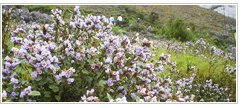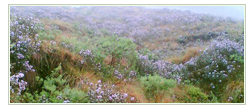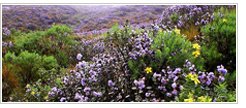Neelakurinji
The misty hill station of Munnar located in Idukki district of Kerala is a tourist’s paradise that is blessed with a rich variety of exotic flora and fauna. Situated about 1600 mts above sea level, Munnar is well known for its vast expanse of Neelakurinji flowers. It bloomed in the year 2006 and once again in 2009 and attracted large crowds to Munnar. Though the massive flowering happens once only in twelve years, the Neelakurinji blooms in small quantity, sometimes a few plants only, at places around Munnar such as Santhampara owing to the fact that different varieties of plants have different flowering cycles.The plant has a strange life cycle in that it dies after the once-in-twelve-year blooming phase. Botanists identified its periodic flowering as early in 1838. These belong to 'Acanthecea family’.In facts there are different varieties of 'Kurinji', which flower at intervals between seven and twelve years, they say. This delicate shrub grows to the height of about two feet, and takes root on the poorer soils on steep grassland slopes.
about 1600 mts above sea level, Munnar is well known for its vast expanse of Neelakurinji flowers. It bloomed in the year 2006 and once again in 2009 and attracted large crowds to Munnar. Though the massive flowering happens once only in twelve years, the Neelakurinji blooms in small quantity, sometimes a few plants only, at places around Munnar such as Santhampara owing to the fact that different varieties of plants have different flowering cycles.The plant has a strange life cycle in that it dies after the once-in-twelve-year blooming phase. Botanists identified its periodic flowering as early in 1838. These belong to 'Acanthecea family’.In facts there are different varieties of 'Kurinji', which flower at intervals between seven and twelve years, they say. This delicate shrub grows to the height of about two feet, and takes root on the poorer soils on steep grassland slopes.
The Nilgiris meaning Blue Mountains derives its name from the wild Neelakurinji flowers which during its flowering season, carpets the whole of the mist-clad hill ranges in a swathe of blue and beckons the tourists to experience the scenic beauty. Neela means blue in Malayalam language and Kurinji is the local name of the flower. Botanists state that there are about 300 species of this plant in several hues that bloom in 10 to 16 years and the legendary and most admired Neelakurinji is the best known among them. About 46 of them are found in India . Plants that bloom at long intervals like this is called plietesials. These are mostly found on the hills of high altitude. The main habitat of Neelakurinji is the hills surrounding Munnar which is in the Western Ghats. It has become a symbol of bio-diversity of the Western Ghats. This endemic species is also an indicator of the health of the ecosystem. It may well be claimed as flagship species of the mountains.
among them. About 46 of them are found in India . Plants that bloom at long intervals like this is called plietesials. These are mostly found on the hills of high altitude. The main habitat of Neelakurinji is the hills surrounding Munnar which is in the Western Ghats. It has become a symbol of bio-diversity of the Western Ghats. This endemic species is also an indicator of the health of the ecosystem. It may well be claimed as flagship species of the mountains.
Neelakurinji (Strobilanthes kunthiana) is a bush with several branches. The species name Kunthiana has been derived from the River Kunthi which flows through the rich expanse of the renowned Silent Valley National Park in Kerala. It means that the plant has been first described from the vicinity of this river. The plant grows profusely around Shola grasslands and mountain slopes of the mighty Western Ghats and Nilgiris in India. Neelakurinji blooms in a clustered manner on typical inflorescence stocks once in every 12 years. The flowering season ranges between August and November with a peak period of late September and October although some varieties exhibit little variation in their phrenology. The flower has a purplish blue colour when aged. It looks light blue in the earlier stage of blooming.
.
Kurinji sanctuary declared
About 32 sq. km core habitat of the endangered Neelakurinji plant is preserved in Kurinjimala Sanctuary in Kottakamboor and Vattavada villages in Devikulam Taluk, Idukki district of Kerala State in South India. The area was declaried a sanctuary by the Kerala Forest Minister Benoy Viswam at the Neelakurinji Fest at Munnar which took place on 7th October 2006. The sanctuary was declared in the light of renewed efforts to preserve the unique biodiversity of the area. It has been estimated that about ten lakh tourists visited Neelakurinji at Munnar during the bloom in 2006.
lakh tourists visited Neelakurinji at Munnar during the bloom in 2006.
However it’s sad to note that the last few decades witnessed impairment to the habitat of the Neelakurinji. Plantations of tea, cardamom and timber devastated a stupendous range of pristine forests home to this rare bush. Vast stretches of virgin rain forests got drowned by some hydro-electric schemes and activities. Tea plantations engorged maximum space of the Kurinji-filled hills. Today the Kurinji species thrives only in the valleys and gorges that remain undistorted and unpolluted.
Another anthropogenic threat witnessed this year is the indiscriminate collection and destruction of bushes and stocks of Neelakurinji by some unaware and unruly visitors. This is particularly noticeable in some of the Neelakurinji habitats around Ooty in the Nilgiris. In the last week of September, the peak season, many tourists were observed to have gone on a rampage inside Neelakurinji thickets at Kodanadu in Kotagiri. They were also found to collect bunches of these flowers in gay abandon.
In addition to habitant destruction, such impudent activities may well prove serious threats to the long term survival of this important member of the biodiversity of these mountains.
Campaigns on preservation
Several awareness campaigns and efforts at preservation of the flower species have been going on in different parts of Kerala and Tamil Nadu. In support of the endeavors to save the endangered Kurinji blooms, the postal department has released a Rs.15/- postal stamp on the Neelakurinji at Udhagamandalam on 29th May 2006. The Kozhikode Philately Bureau has brought out a special postal pack `Bouquet of Western Ghats' in connection with the release of the postal stamp. The pack contains the depiction of the postal stamp on the Neelakurinji and a picture post card of the stamp. This will be a valued souvenir for the tourists.
and Tamil Nadu. In support of the endeavors to save the endangered Kurinji blooms, the postal department has released a Rs.15/- postal stamp on the Neelakurinji at Udhagamandalam on 29th May 2006. The Kozhikode Philately Bureau has brought out a special postal pack `Bouquet of Western Ghats' in connection with the release of the postal stamp. The pack contains the depiction of the postal stamp on the Neelakurinji and a picture post card of the stamp. This will be a valued souvenir for the tourists.
The Kurinji's campaigners have also been conducting annual trips from Kodaikanal (Tamil Nadu ) to Munnar ( Kerala ) to voice their demand to declare the 95sq.km expanse between Kodaikanal and Munnar, located at a height of 1,600m, as a Kurinji sanctuary, which has fianally materialised.
The departments of Tourism, Forests and Wildlife and other departments of Kerala Government had jointly organized ‘Neelakkurinji Festival 2006’ from 7th October to 9th October 2006, featuring photo exhibitions, art displays, food & trade fairs, poster competitions and seminars highlighting the importance of this exotic plant.
